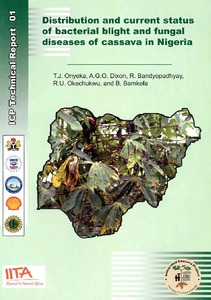| dc.contributor.author | Asiedu, Robert |
| dc.contributor.author | Mignouna, H. |
| dc.contributor.author | Odu, B. |
| dc.contributor.author | Hughes, J. |
| dc.date.accessioned | 2019-12-04T11:24:12Z |
| dc.date.available | 2019-12-04T11:24:12Z |
| dc.date.issued | 2003 |
| dc.identifier.citation | Asiedu, R., Mignouna, H., Odu, B., & Hughes, J. D. A. (2003). Yam breeding. In Proceedings of a conference on Plant Virology in Sub Saharan Africa, (pp. 466-475), 4-8 June 2001, Ibadan, Nigeria. |
| dc.identifier.isbn | 978-131-214-9 |
| dc.identifier.uri | https://hdl.handle.net/20.500.12478/4307 |
| dc.description.abstract | Yams (Dioscorea species of family Dioscoreaceae) are important for food, income, and sociocultural activities especially in West and Central Africa and account for about 93% of the world’s annual production of 38 million tonnes. Breeding of yams is focused primarily on the two dominant species, D. rotundata Poir. and D. alata L., and it is carried out within the context of improving yam-based systems. Constraints to productivity of cultivation and opportunities for improvement are identifi ed through reviews of existing information, new surveys, or stakeholders’ meetings. Hence the principal objectives for breeding include high and stable tuber yield, resistance to pests (e.g., nematodes) and diseases (e.g., viruses, anthracnose), as well as tuber characteristics (shape, food quality) desired by consumers. Viruses are of particular concern in yam research and development because they impose a double limitation in the form of reduced fi eld
performance as well as restricted international exchange of germplasm. Of the several viruses infecting yams, the most commonly occurring in West Africa is the Yam mosaic virus (YMV), genus Potyvirus. Field and screenhouse evaluation of Dioscorea germplasm held at IITA has resulted in the identifi cation of high levels of resistance to the virus in Dioscorea landrace cultivars. The inheritance of resistance to the virus in D. rotundata has been established through positive screening of populations at the seminal and clonal stages. These sources form the basis for population improvement towards the development of new yam varieties with higher levels of virus resistance. |
| dc.language.iso | en |
| dc.subject | Yams |
| dc.subject | Food Production |
| dc.subject | Value Chain |
| dc.subject | Dioscorea |
| dc.title | Yam breeding |
| dc.type | Conference Paper |
| dc.type | Conference Paper |
| dc.description.version | Peer Review |
| cg.contributor.affiliation | International Institute of Tropical Agriculture |
| cg.coverage.region | Africa |
| cg.coverage.region | West Africa |
| cg.coverage.country | Nigeria |
| cg.authorship.types | CGIAR single centre |
| cg.iitasubject | Yam |
| cg.accessibilitystatus | Limited Access |
| local.dspaceid | 99873 |

